6.2 Flow with It: The Stages of Memory
Think of all the information streaming through your sensory channels at this very moment. Your eyes may be focused on this sentence, but you are also collecting data through your peripheral vision. You may be hearing noises (the hum of a fan), smelling odors (dinner cooking in the kitchen), tasting foods (if you are snacking), and even feeling things (your back pressed against a chair). Many of these sensory stimuli never catch your attention, but some are being registered in your sensory memory, the first stage of the information-
222
INFOGRAPHIC 6.1
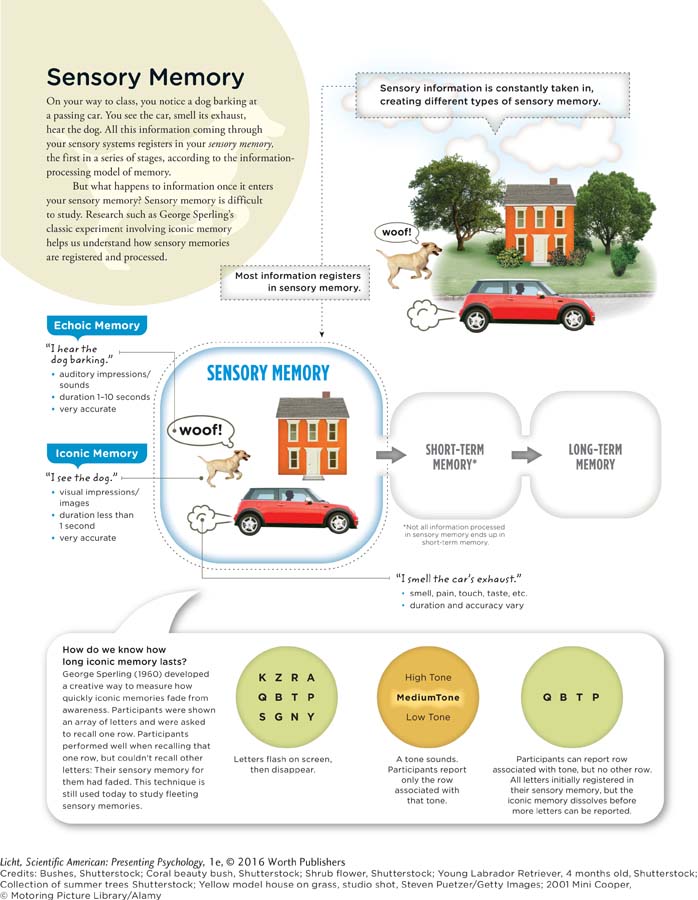
Sensory Memory: The Here and Now
LO 4 Describe sensory memory.
The bulk of information entering sensory memory comes and goes like the images on a movie screen. A few things catch your attention—
223
ICONIC MEMORY: “MORE IS SEEN THAN CAN BE REMEMBERED” Interested in how the brain processes data entering the visual channel, Harvard graduate student George Sperling (1960) designed an experiment to determine how much information can be detected in a brief exposure to visual stimuli. Sperling set up a screen that flashed multiple rows of letters for one-
iconic memory Visual impressions that are photograph-
Sperling was convinced that “more is seen than can be remembered” (1960, p. 1), so he devised a clever method called partial report to provide evidence. As with the original experiment, he briefly flashed an array of letters (for example, three rows of four letters), with all rows visible. But instead of having the participants report what they remembered from all the rows, he asked them to report what they remembered from just one row at a time (Infographic 6.1). Here’s how the study went: The array of letters was flashed, and once it disappeared, a tone was sounded. When participants heard a high-

try this
Stare at the photo of the child laughing and then shut your eyes. Does an image of the child linger in your mind’s eye for just a moment? How long do you think this iconic memory lasts?
EIDETIC IMAGERY Perhaps you have heard friends talk about someone who claims to have a “photographic memory” that can record and store images with the accuracy of a camera: “My cousin Dexter can look at a textbook page, remember exactly what it says in a few seconds, and then recall the information days later, seeing the pages exactly as they were.” That may be what Dexter claims, but is there scientific evidence to back up such an assertion? We doubt it.
According to some reports, though, researchers have documented a phenomenon that comes fairly close to photographic memory. It’s called eidetic imagery (ī-ˈde-
CONNECTIONS
In Chapter 3, we described sensory adaptation, the process by which we become less aware of constant stimuli. This allows us to focus on changes in our environment, an ability invaluable to survival. Humans are exquisitely sensitive to even the slightest changes in auditory stimuli, and our echoic memory allows us to store and follow changes in sounds.
echoic memory (ə-ˈkō-ik) Exact copies of the sounds we hear; a form of sensory memory.
224
ECHOIC MEMORY Exact copies of the sounds we hear linger longer than visual impressions; echoic memory (ə-kō-ik) can last from about 1 to 10 seconds (Lu, Williamson, & Kaufman, 1992; Peterson, Meagher, & Ellsbury, 1970), and it can capture very subtle changes in sound. Research has shown that the introduction of a single tone played for 300 milliseconds initiates changes in cortical activity (Inui et al., 2010). Even if you are not aware of it, your auditory system is picking up slight changes in stimuli and storing them in echoic memory for a brief moment, so you don’t have to pay attention to every incoming sound. Perhaps you have had the following experience: During class, your instructor notices a classmate daydreaming and tries to bring her back to reality: “Olivia, could you please restate the question for us?” Her mind was indeed wandering, but amazingly she can recall the instructor’s last sentence, responding, “You asked us if brain scans should be allowed as evidence in courtrooms.” For this, Olivia can thank her echoic memory.
Although brief, sensory memory is critical to the creation of memories. Without it, how would information enter the memory system in the first place? We have discussed iconic and echoic memory, which register sights and sounds, but memories can also be rich in smells, tastes, and touch. Remember, data received from all the senses are held momentarily in sensory memory. The bulk of research has focused on iconic and echoic memories, but psychologists propose that we also have similar sensory stores for the other senses.
Short-
LO 5 Summarize short-
Synonyms
maintenance rehearsal rote rehearsal
maintenance rehearsal Technique of repeating information to be remembered, increasing the length of time it can be held in short-
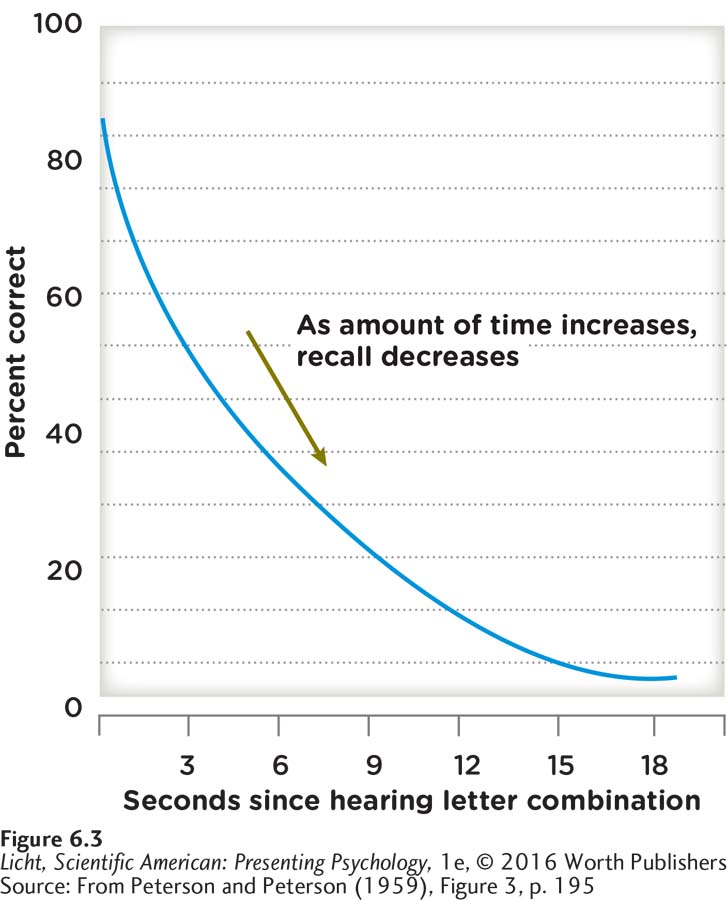
Distraction can reduce the amount of time information remains in short-
When information enters your sensory memory, it does not linger. So where does it go next? If not lost in the overwhelming array of sensory stimuli, the data proceed to short-
But maintenance rehearsal does not work so well if you are distracted. In a classic study examining the duration of short-
CONNECTIONS
Here, we see how memory is related to attention. In Chapter 4, we talked about the limited capacity of human attention. At any given point in time, there are only so many items you can attend to and thus move into your memory system.
225
At any given moment, you can only concentrate on a tiny percentage of the data flooding your sensory memory. Items that capture your attention can move into your short-
Apply This
Multitasking and Memory
It’s Sunday evening, and you need to catch up on the reading for your psychology class. You sit down in a quiet place and open your textbook. But just as you are getting into the psychology groove, a little “bloop bloop” jolts you out of the mental flow. A text bubble appears in the corner of your computer screen: OMG . . . blah blah blah . . . LOL! You begin an instant messaging (IM) conversation that continues on-
CONNECTIONS
In Chapter 1, we discussed correlations, or relationships between two variables. Here, we note a negative correlation: As time spent using communication technologies goes up, GPA goes down. But correlation does not prove causation; perhaps people with lower GPAs have less interest in studying, and thus more time to socialize. Or, maybe there is a third factor, such as the ability to manage time effectively, influencing both variables.
Psychologists from Central Connecticut State University wondered the same thing, so they did what any good researchers would do: They designed an experiment to find answers. The participants in their study were people very much like you—
HOW TO LOWER YOUR GPA USING FACEBOOK
Here’s what they found: The students who IMed during the reading task performed at roughly the same level as their non-
Multitasking, whether it involves texting, using Facebook, or IMing, inevitably requires a shift in attention, and this is hard work for the brain, which has to engage and disengage different networks (Clapp, Rubens, Sabharwal, & Gazzaley, 2011). Keep this in mind the next time you consider using your smart phone behind the wheel. Texting while driving increases the likelihood of crashing or coming close to crashing by 23 times (Olson, Hanowski, Hickman, & Bocanegra, 2009), and studies show that using a cell phone impairs driving to the same degree as drunkenness (Strayer & Watson, 2012, March).
226
LO 6 Give examples of how we can use chunking to improve our memory span.

The Digit Span test is a simple way to assess memory. Participants are asked to listen to a string of numbers and then repeat them. The string of numbers grows longer as the test progresses. Ask a friend to give you this test and see how many numbers you can remember. For a real challenge, you can even try to recite the list backward!
Now that we have established how important attention is for your success and safety, let’s return to the memory stage to which it is so intimately tied: short-
chunking Grouping numbers, letters, or other items into meaningful subsets as a strategy for increasing the quantity of information that can be maintained in short-
Consider this example: Your friend has just gotten a new phone number, which she tells you as the elevator door is closing between you. How are you going to remember her number long enough to create a new entry in your cell phone? You could try memorizing all 10 digits in a row (8935550172), but a better strategy is to break the number into more manageable pieces (893-
Short-
Working Memory: Where the Action Is
LO 7 Explain working memory and how it compares with short-
working memory The active processing of information in short-
Subsequent conceptualizations of the information-
But not everyone agrees on the distinctions between short-
Now let’s take a closer look at the model of working memory originally proposed by psychologists Alan Baddeley and Graham Hitch (1974), which has been updated and revised over the years (Baddeley, 2002). According to this model, the purpose of working memory is to actively maintain information, aiding the mind as it performs complex cognitive tasks. To accomplish this, working memory has four components with specific functions: the phonological loop, the visuospatial sketchpad, the central executive, and the episodic buffer (Baddeley, 2002; Figure 6.5).
227
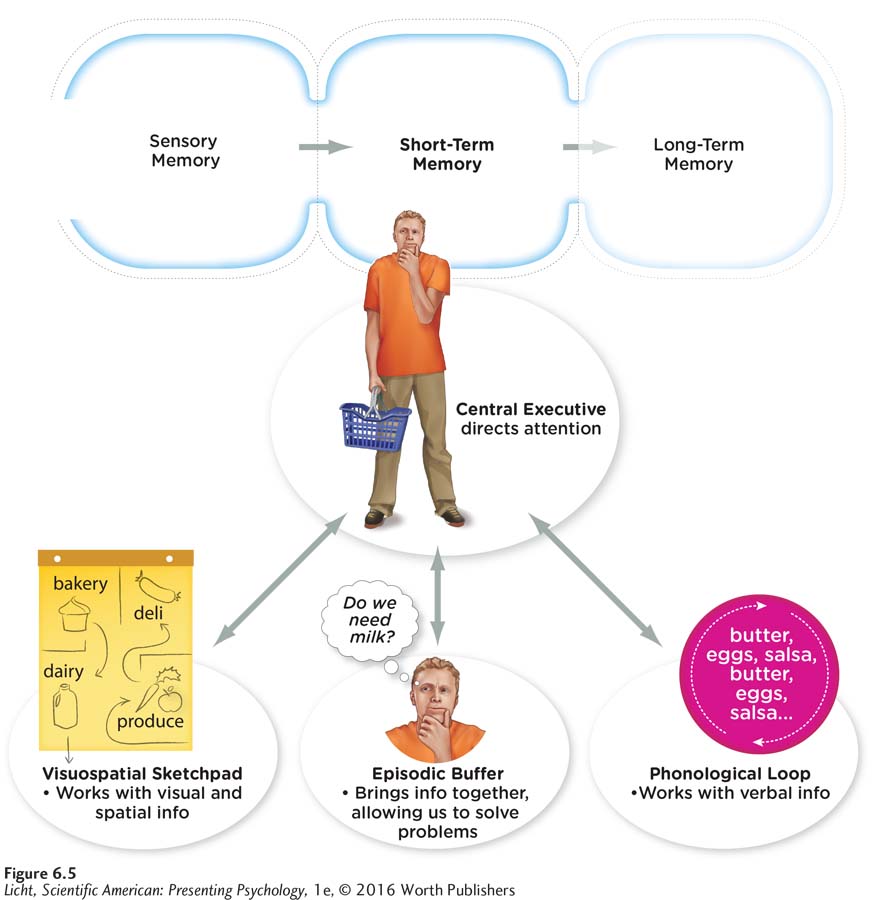
Working memory represents the active processing occurring in short-
PHONOLOGICAL LOOP The phonological loop is responsible for working with verbal information for brief periods of time; when exposed to verbal stimuli, we “hear” an immediate corollary in our mind. This component of working memory is what we use, for example, when we are reading, trying to solve problems, or learning new vocabulary. Most of us can only manipulate about 2 seconds’ worth of verbal material in this loop without actively trying to repeat it (Baddeley, 2000; Baddeley & Hitch, 1994). Imagine you are trying to remember the passcode for your debit card. You know it is somehow related to your first zip code, so you retrieve your zip code from long-
VISUOSPATIAL SKETCHPAD The visuospatial sketchpad is where visual and spatial data are briefly stored and manipulated, including information about your surroundings and where things are in relation to each other and you. This working memory component allows you to close your eyes and reach for the coffee mug you just set down. We can also use information from long-
228
CENTRAL EXECUTIVE The central executive has responsibilities similar to those of the chief executive in any organization—
EPISODIC BUFFER The episodic buffer is the part of working memory where information from the phonological loop, visuospatial sketchpad, and long-
As you know, working memory is limited in its capacity and duration. So how do we maintain so much information over the years? What aspect of memory makes it possible to memorize thousands of vocabulary words, scores of names and facts, and lyrics to your favorite songs? Enter long-
Long-
Items that enter short-
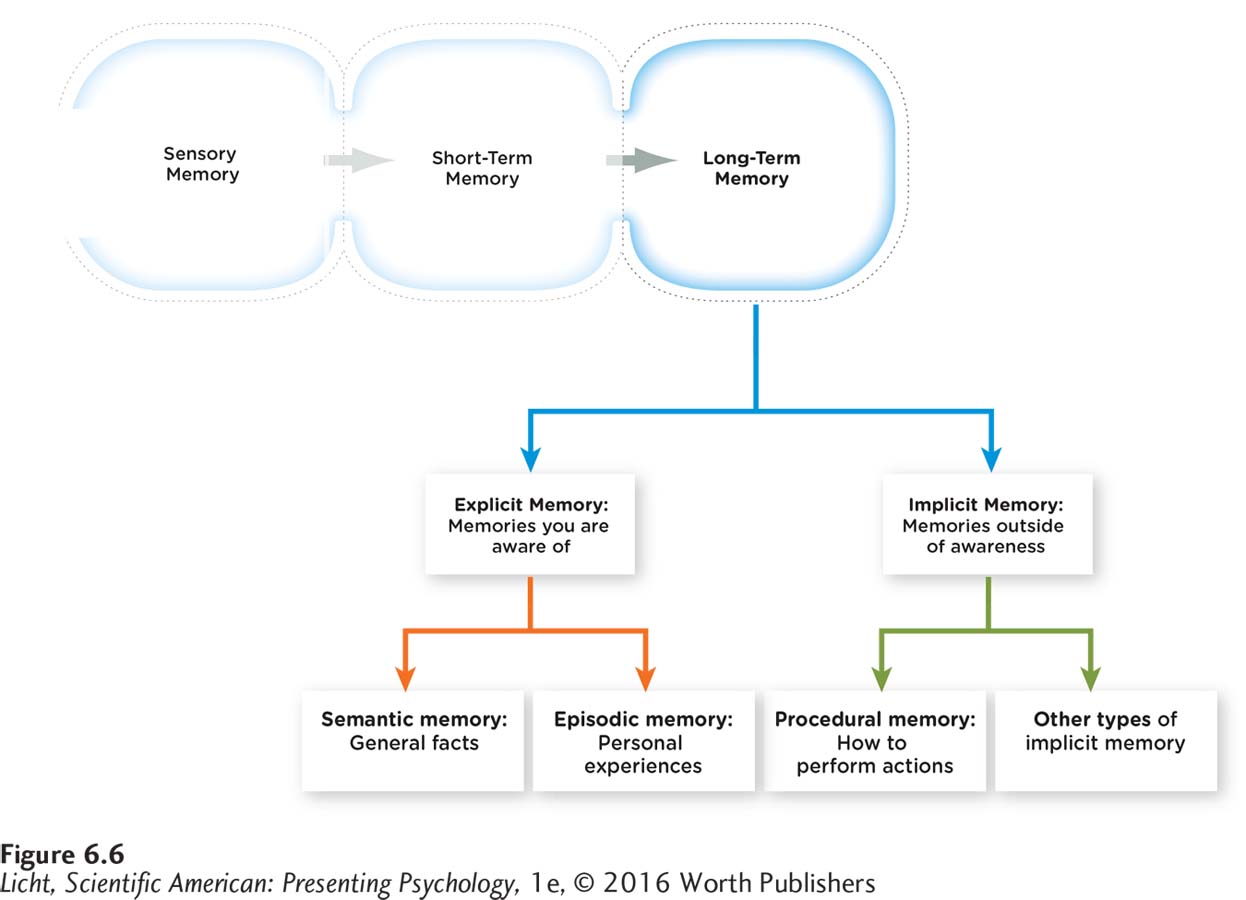
229
LO 8 Describe long-
Synonyms
explicit memory declarative memory
implicit memory nondeclarative memory
explicit memory A type of memory you are aware of having and can consciously express in words or declare, including memories of facts and experiences.
semantic memory The memory of information theoretically available to anyone, which pertains to general facts about the world; a type of explicit memory.
episodic memory (e-
EXPLICIT MEMORY Long-
flashbulb memory A detailed account of circumstances surrounding an emotionally significant or shocking, sometimes historic, event.
FLASHBULB MEMORIES Often our most vivid episodic memories are associated with intense emotion. Think about an emotionally charged experience from your past: receiving news that a loved one has died, getting engaged, or being the victim of an assault. If recollecting these events feels like watching a 4-
Because flashbulb memories seem so strong, vivid, and rich in detail, we often place great confidence in them, but research suggests that we should be cautious about doing this. Flashbulb memories sometimes include inaccuracies or lack some specific details (Neisser, 1991; Talarico & Rubin, 2003).
implicit memory A memory of something you know or know how to do, but that might be automatic or unconscious; this type of memory is often difficult to bring to awareness and express.
procedural memory The unconscious memory of how to carry out a variety of skills and activities; a type of implicit memory.
IMPLICIT MEMORY Unlike explicit memory, which can easily flow into conscious thought, implicit memory is difficult to bring into awareness and express. It is a memory for something you know or know how to do, but which might be automatic or unconscious. Many of the physical activities we take for granted, such as playing an instrument, driving a car, and dribbling a basketball, use a special type of implicit memory called procedural memory, that is, the memory of how to carry out an activity without conscious control or attention. After his illness, Clive Wearing could still pick up a piece of music and play it on the piano. He had no recollection of learning to sight-
230
CONNECTIONS
In Chapter 5, we introduced the concept of classical conditioning, which occurs when an originally neutral stimulus is conditioned to elicit or induce an involuntary response, such as salivation, eyeblinks, and other types of reflex reactions. Here we can see how closely linked learning and memory are.
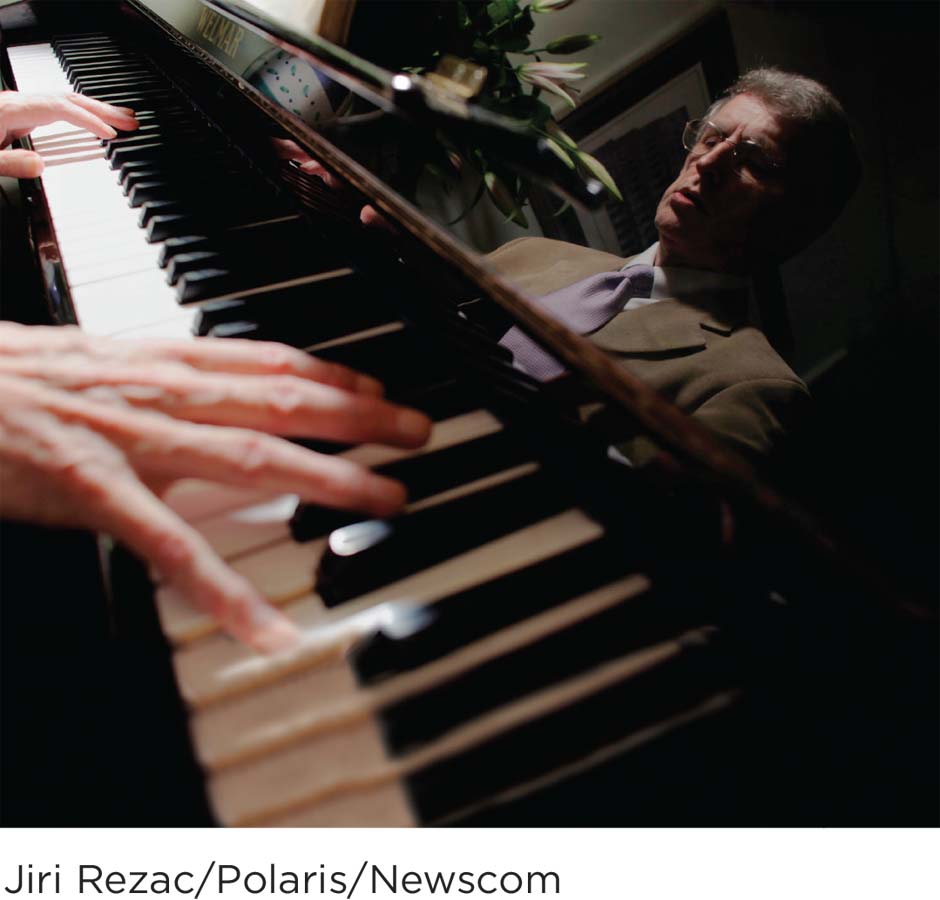
Following his bout with encephalitis in 1985, Clive could still read music and play the piano, demonstrating that his procedural memory was not destroyed. Researchers documented a similar phenomenon in a professional cello player who battled herpes encephalitis in 2005 (Vennard, 2011, November 21).
Memories acquired through classical conditioning are also implicit. Let’s say you enjoy eating food at McDonald’s and the very sight of the golden arches makes you salivate like one of Pavlov’s dogs. Somewhere along the line, you formed an association, a memory linking the appearance of that restaurant to juicy hamburgers and creamy shakes, but the association does not require your conscious awareness (Cowan, 1988). It is implicit.
Improving Memory
How does the process of moving data into the memory system create long-
Take 15 seconds and try to memorize these seven words in the order they appear.
puppy stop sing sadness soccer kick panic
Now close your eyes, and see how many you recall. How did you do?
try this
mnemonic (nih-
You just completed a miniversion of “Random Words,” Dorothea’s favorite event in the World Memory Championships. Dorothea won a gold medal in this category, committing 244 words to memory in 15 minutes. What’s her secret? She uses mnemonic (nih-
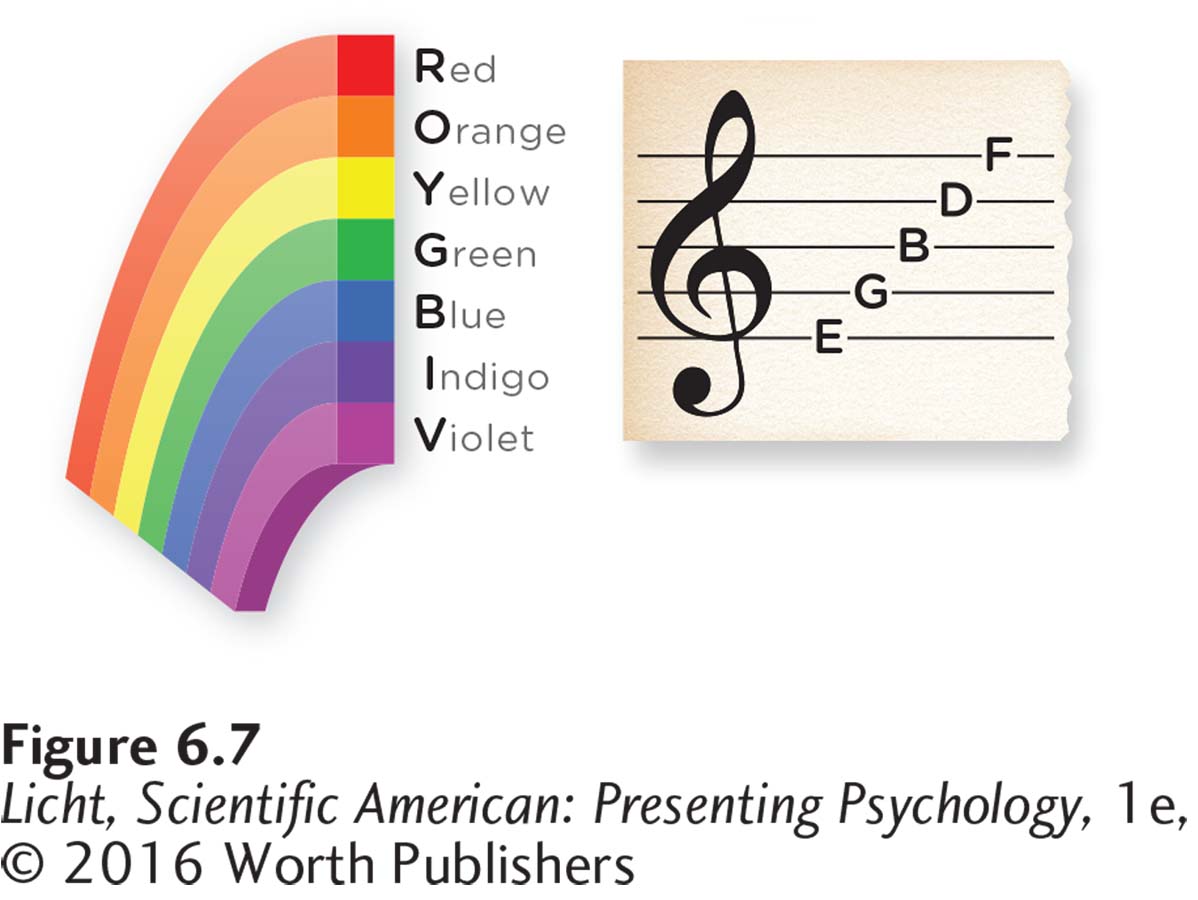
Mnemonics enable us to translate information into a form that is easier to remember. For example, the common acronym ROY G BIV helps us remember the order of the seven colors in the rainbow. And when music students have trouble remembering the notes on the lines of the treble clef (EGBDF), they often rely on the first-
Apply This
INFOGRAPHIC 6.2
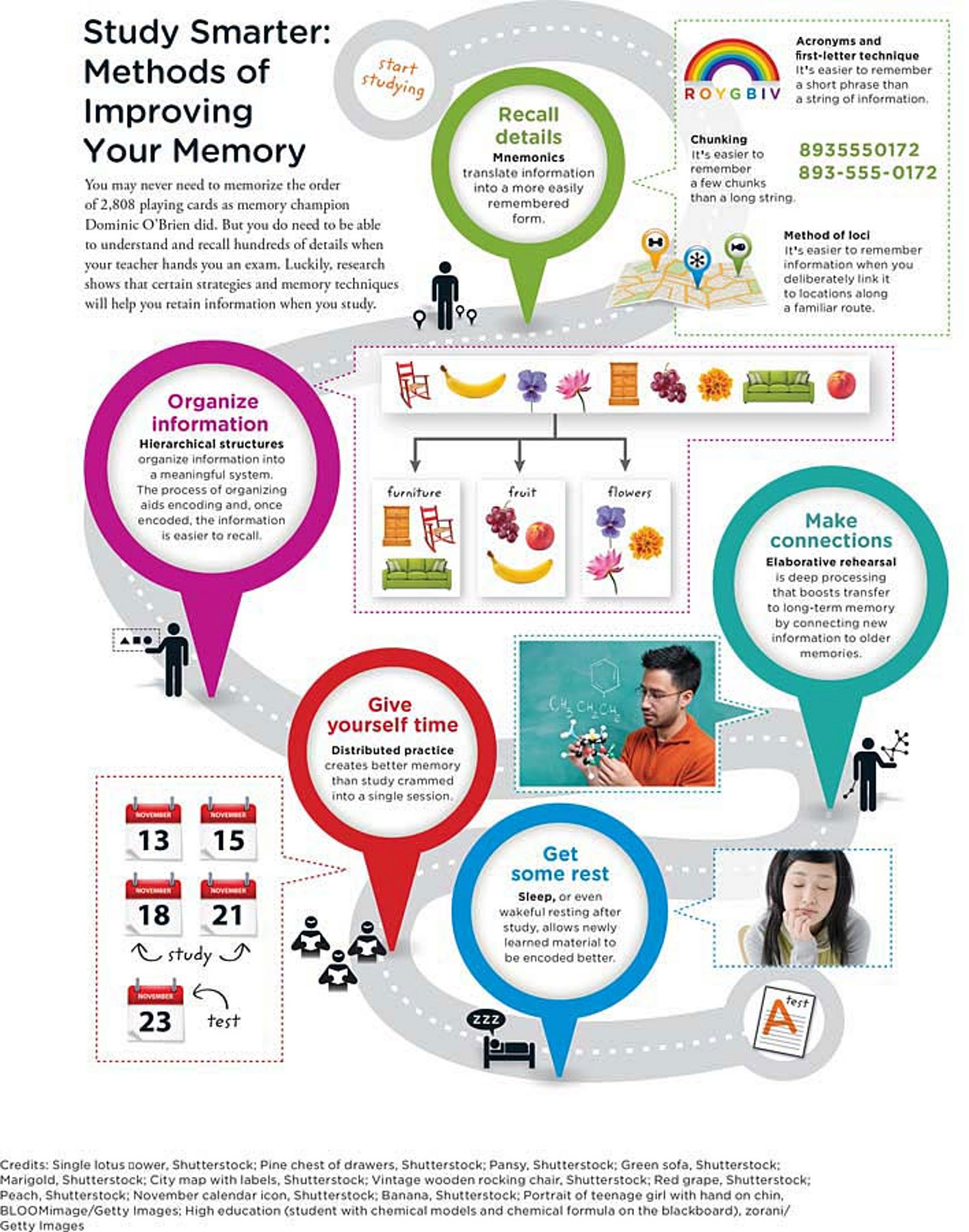
METHOD OF LOCI One of the mnemonics Dorothea relies on most is the method of loci (lō-ˌsī, meaning “places”). Here’s how it works: When presented with a series of words to remember, Dorothea takes them on a mental journey through the place she knows best: her bedroom and bathroom. Walking through her room, she puts the items-
231
232
You can use the method of loci, too. Just pick a familiar route—
HIERARCHICAL STRUCTURES Another way to boost your memory is to arrange the material you are trying to memorize into a hierarchy, or a system of meaningful categories and subcategories. In a classic study, researchers found that if participants were given a list of words that followed a hierarchical structure, they were better able to recall the words than participants learning the same words not organized in any meaningful way. In fact, the participants who had learned the words using the hierarchy were able to recall three times as many words as the other group (Bower, Clark, Lesgold, & Winzenz, 1969).
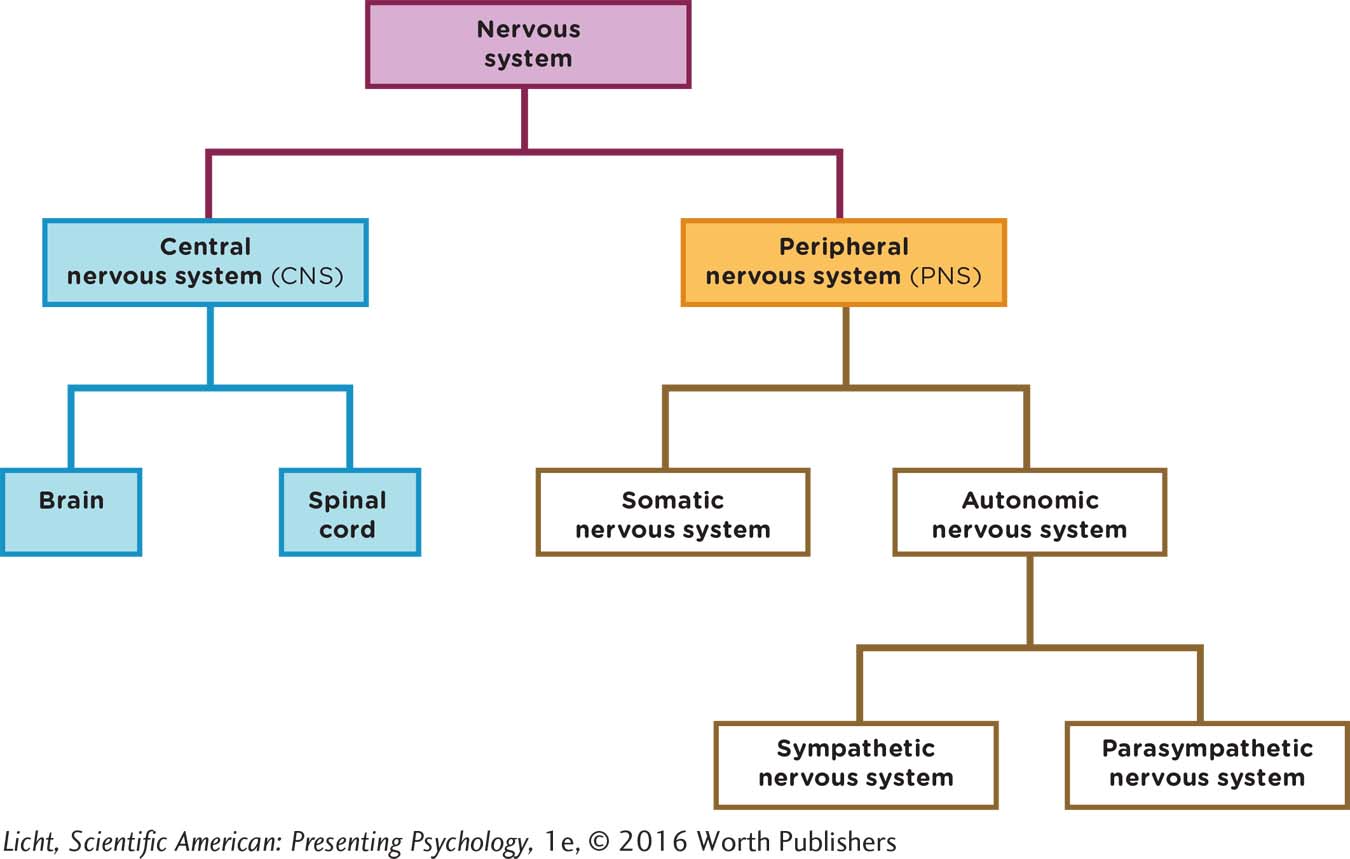
try this
Try to remember the various divisions of the nervous system. Sketch a diagram like the one here (this is from Figure 2.2 from Chapter 2) showing the relationships among the concepts, starting with the most general and ending with the most specific.
effortful processing The encoding and storage of information with conscious effort, or awareness.
CONNECTIONS
In Chapter 4, we described automatic processing, the collection and retention (sometimes temporary) of information with little or no conscious effort. Automatic processing can also refer to the automatic cognitive activity that guides some behaviors, enabling us to act without focusing attention on what we are doing. Without our awareness, the brain determines what needs attention and what can be processed for later use.
AUTOMATIC AND EFFORTFUL PROCESSING As you recall from earlier in the chapter, the levels of processing framework suggests that stronger memories result when you think about information on a deep level. Dorothea and her rivals came to the championships expecting to use effortful processing. As the name implies, effortful processing is not only intentional but also requires work (Hartlage et al., 1993; Hasher & Zacks, 1979). Some types of effortful processing, such as maintenance rehearsal, are useful for extending the amount of time you can hold onto information in short-
233
We should note that some encoding occurs through automatic processing—that is, with little or no conscious effort or awareness (Hartlage, Alloy, Vázquez, & Dykman, 1993; Hasher & Zacks, 1979). For example, when Dorothea walked into the conference room at the World Memory Championships, she processed all sorts of information without even trying—
elaborative rehearsal The method of connecting incoming information to knowledge in long-
Synonyms
distributed practice spacing effect
ELABORATIVE REHEARSAL AND VISUALIZATION Effortful processing is evident in elaborative rehearsal, the method of connecting incoming information to knowledge in long-
CONNECTIONS
In Chapter 1, we presented the sociocultural perspective of psychology, which suggests that we should examine the influences of social interactions and culture to understand behavior. Here, we see how culture can influence decisions about the way to study.
massed practice Studying for long periods of time without breaks.
distributed practice Spreading out study sessions over time with breaks in between.
DISTRIBUTED PRACTICE What other strategies might improve encoding and help you move information into long-
234
across the WORLD
Memory and Culture
 Ask a person from the United States and a person from China to recount some life memories, and you may detect some interesting cultural themes in their reports. Research suggests that Chinese people are more likely than Americans to remember social and historical occurrences and focus their memories on other people. Americans, on the other hand, tend to recall events as they relate to their individual actions and emotions (Wang & Conway, 2004). Why is this so?
Ask a person from the United States and a person from China to recount some life memories, and you may detect some interesting cultural themes in their reports. Research suggests that Chinese people are more likely than Americans to remember social and historical occurrences and focus their memories on other people. Americans, on the other hand, tend to recall events as they relate to their individual actions and emotions (Wang & Conway, 2004). Why is this so?
MEMORIES OF WE, OR MEMORIES OF ME?
It may have something to do with the fact that China—

A group of Chinese boys enjoy each other’s company. China has a community-
CONNECTIONS
In Chapter 4, we discussed how sleep and dreams relate to memory. For example, researchers suspect that sleep spindles are associated with memory consolidation, and some theorists emphasize the importance of REM sleep in this process.
SLEEP AND MEMORY We have touched on many strategies for boosting memory, from chunking to visualization to distributed practice. If we could leave you with one final piece of advice, it would be the following: SLEEP. Exactly how sleep promotes memory is still not completely understood, but there is no question that good sleep makes for better processing of memories (Born, Rasch, & Gais, 2006; Diekelmann & Born, 2010; Marshall & Born, 2007). Even periods of “wakeful resting” can be of benefit. Participants who experienced a 15-
“Wow, that’s a lot to remember,” you may be saying. Hopefully, you can retain it with the help of some of the mnemonic devices we have presented. You might also take a wakeful resting break in preparation for the next section, which focuses on the topic of memory retrieval.
show what you know
235
Question 1
1. According to the information-
10 seconds
30 seconds
45 seconds
60 seconds
b. 30 seconds
Question 2
2. As you enter the airport, you try to remember the location of the baggage claim area. You remember the last time you picked up your friend at this airport, and using your visuospatial sketchpad, realize the area is to your left. This ability demonstrates the use of your:
sensory memory.
working memory.
phonological loop.
flashbulb memory.
b. working memory.
Question 3
3. __________ memory is the type of memory you are aware of having and can consciously declare, whereas __________ memory is for something you know or know how to do, but that might be automatic or unconscious.
Explicit; implicit
Question 4
4. On 9/11 Tanya was watching television when a news bulletin announced the terrorist attacks. She has vivid memories of that moment, including what she was doing, the friends she was with, and many details of her surroundings. This type of memory is known as a(n):
phonological loop.
sensory memory.
implicit memory.
flashbulb memory.
d. flashbulb memory.
Question 5
5. Develop a mnemonic device to help you memorize the following terms from this section: explicit memory, semantic memory, episodic memory, flashbulb memory, implicit memory, and procedural memory.
Answers will vary. Exquisitely Serious Episodes Flashed Impossible Proteins
Explicit memory, Semantic memory, Episodic memory, Flash-